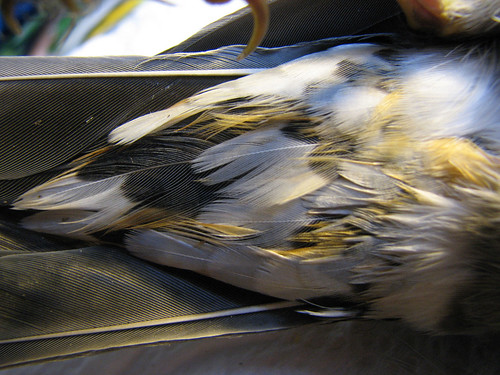tags: Varied Thrush, Ixoreus naevius, birds, mystery bird, bird ID quiz
[Mystery bird] Varied Thrush, Ixoreus naevius, photographed in central Ontario. The bird died after striking the window of lakeside cottage fringed with Eastern Hemlock, Red Oak, Winterberry and American Bittersweet. [I will identify this bird for you tomorrow]
Image: Michael Butler, 16 November 2008. [larger view].
Please name at least one field mark that supports your identification.
Original blog entry about this bird.


I'm thinking that I'm looking at the undertail coverts and the underside of the tail, with a bit of the bird's right wing visible at the top. There's also a ginormous scary-looking claw, or something, descending from the top of the frame, but I've got no idea what that is, so I'm going to ignore it.
It's helpful that this is November in central Ontario, since it cuts down on the number of possibilities. At first I was thinking Evening Grosbeak (because of those bits of yellow in there), but the illustrations in Sibley don't show anything like the flecked plumage pattern in this photo in the grosbeak's undertail coverts.
Some more poking around turns up the crossbills (Red and White-winged), both of which are good in terms of the location and time of year, both of which feature a first-year male plumage with some yellow-gold coloring underneath, and both of which have a flecked appearance in the undertail covers, at least according to Sibley's illustrations.
But which crossbill might this be? White-winged has a winter range that covers all of Ontario, while Red is only found in the southern half, which pushes me slightly in the direction of White-winged. And then I notice the following in Sibley's description: "The smaller-billed White-winged Crossbill prefers smaller cones than Red, mainly larch, hemlock, and spruce." Hm. The description made a point about listing the trees surrounding this particular cottage, including Eastern Hemlock.
I'm going with White-winged Crossbill, possibly a first-year male.
The people who own the cabin should put window guards on their windows to prevent this. When we first moved in, a small bird crashed into our windows. The next day, I put up window guards and screens to prevent this. In 10 years we haven't had another one crash into our windows.
Anyone considered the possibility of a raptor? Possibly an Accipiter. Which one has spotted untertail coverts? Is it a Sharp-shinned Hawk or a Cooper's Hawk?
How about a woodpecker? Look at the large, stiff tail feathers, and yes, that big hind claw (though it may be distorted by the angle of the photo). Yellow-Bellied Sapsucker, perhaps a young one?
I'm thinking its an American Robin. The mostly whitish undertail coverts with tinge of orange, the dark tail seems to match and the size seems about right.
colin -- you were the closest of everyone who tried to identify this bird! wow, good call!
Yes, well done Colin. It was a dirty trick to choose a bird that's a vagrant to Ontario.
The crafty John Callander correctly deduced that there was an ID hint in the description of the nearby flora. Like all thrushes, this species is a sometimes-frugivore. The crop of the bird contained freshly ingested Celastrus fruit - not Viburnum, as I had initially mis-ID'd.
Heh. Yes, I was crafty -- and craftily worked my way to an ID that was completely wrong.
I love how we were all over the map (and yes, well done, Colin). It may have been a dirty trick to include a vagrant, but it nicely illustrates what I shall henceforth think of as the anthropic principle of mystery bird of the day identification: We aren't walking out in the field and picking a random bird to identify. We're choosing a bird that was deemed interesting enough to photograph, and interesting enough to offer up as MBOD. So it might be a common bird, or it might be a once-in-a-lifetime rarity.
I get a similar feeling when people offer the existence of intelligent life on earth as evidence that intelligence must be common in the universe. it's possible to get in over our heads very quickly if we start trying to draw inductive inferences from a single example. That this bird flew into a window in central Ontario in November is evidence that that happened at least once, but it was fallacious of me to think that therefore it must be something that happens frequently.
Anyway, thanks to all involved for a really interesting mystery bird.